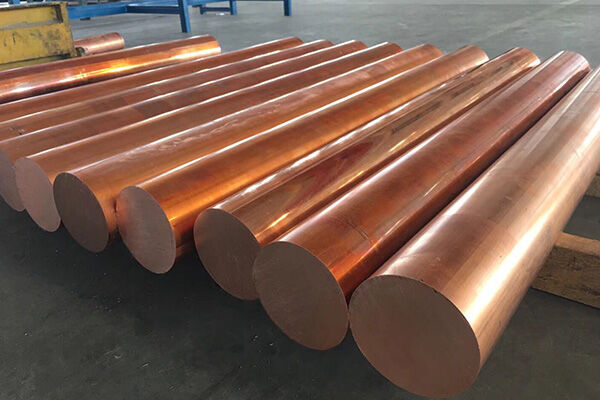
Difference Between Copper, Brass and Bronze
Copper, brass, and bronze, also known as "red metals," may appear to be the same at first glance, but they are actually quite different.

copper
Copper is widely used in various products for its excellent electrical and thermal conductivity, good strength, good formability and corrosion resistance. Pipes and fittings are often made from these metals due to their corrosion resistance. They can be easily welded and brazed, and many can be welded by various gas, arc and resistance methods. They can be buffed and polished to almost any desired texture and sheen.
There are different grades of pure copper that contain different amounts of impurities. Oxygen-free copper grades are designed for functions requiring high electrical conductivity and ductility.
One of the most important properties of copper is its resistance to bacteria. Extensive antimicrobial testing by the EPA found that 355 copper alloys, including many brasses, kill more than 99.9% of bacteria within two hours of contact. Normal discoloration does not affect the antimicrobial effect.
application
Copper was one of the first metals discovered. The Greeks and Romans made it into tools or ornaments, and even historical details show that copper was used to disinfect wounds and purify drinking water. Today, it is most commonly found in electrical materials, such as wiring, because of its ability to conduct electricity efficiently.

brass
Brass is mainly an alloy composed of copper and zinc. Various amounts of zinc or other elements can be added to brass. These different mixtures produce various properties and color variations. Increased zinc content increases the strength and ductility of the material. The color of brass can vary from red to yellow, depending on the amount of zinc in the alloy.
If the zinc content of brass is between 32% and 39%, its hot working ability will be improved, but its cold working ability will be limited.
If brass contains more than 39% zinc (such as Montez metal), it will have higher strength and lower ductility (at room temperature).
application
Brass is often used for decoration, mainly because of its similarity to gold. It is also a commonly used musical instrument due to its high workability and durability.
other brass alloys
tin copper
This is an alloy containing copper, zinc and tin. The alloy group includes Navy Brass, Navy Brass, and Easy Machining Brass. Tin is added to inhibit dezincification (leaching of zinc from brass alloys) in many environments. This group has low sensitivity to dezincification, moderate strength, strong resistance to atmospheric and water corrosion, and good electrical conductivity. Has good thermoformability and cold formability. These alloys are commonly used in the manufacture of fasteners, marine hardware, threaded machine parts, pump shafts and corrosion-resistant mechanical products.
bronze
Bronze is an alloy mainly composed of copper and other components. In most cases, the added ingredient is usually tin, but arsenic, phosphorus, aluminum, manganese and silicon can also be used to create different properties in the material. All of these ingredients produce an alloy that is harder than copper alone.
Bronze is characterized by a dark golden color. You can also tell the difference between bronze and brass because of the faint ringing on the surface of the bronze.
application
Bronze is used to construct sculptures, musical instruments and medals, as well as in industrial applications such as bushings and bearings, where its low metal-to-metal friction is an advantage. Bronze also has nautical applications because of its corrosion resistance.

Other bronze alloys
Phosphor bronze (or tin bronze)
The tin content of this alloy is generally between 0.5% and 1.0%, and the phosphorus content is between 0.01% and 0.35%. These alloys are known for their toughness, strength, low coefficient of friction, high fatigue resistance and fine grain size. The tin content increases the corrosion resistance and tensile strength of the alloy, while the phosphorus content increases the wear resistance and hardness of the alloy. Some typical end applications for this product are electrical products, bellows, springs, gaskets and corrosion resistant equipment.
Aluminum Bronze
The aluminum content ranges from 6% to 12%, the iron content is 6% (maximum), and the nickel content is 6% (maximum). These additive packages increase strength and provide excellent corrosion and wear resistance. The material is commonly used in the manufacture of marine hardware, sleeve bearings and pumps or valves that handle corrosive fluids.
Silicon bronze
This is an alloy that can cover brass and bronze (red silicon brass and red silicon bronze). They typically contain 20% zinc and 6% silicon. Red brass is strong and corrosion resistant and is commonly used for valve stems. Red bronze is very similar, but has a lower zinc content. It is often used to make pumps, valves and other components.
Nickel Brass (or Nickel Silver)
This is an alloy containing copper, nickel and zinc. Nickel gives the material an almost silvery appearance. This material has moderate strength and good corrosion resistance. This material is commonly used to make musical instruments, food and beverage equipment, optical equipment, and other items where aesthetic factors are important.
Copper Nickel (or Cupronickel)
This is an alloy containing 2% to 30% nickel. This material has high corrosion resistance and thermal stability. This material also exhibits very high resistance to corrosion cracking pressure and oxidation in steam or moist air environments. The higher the nickel content, the stronger the corrosion resistance in seawater and the stronger the ability to resist marine biological pollution. This material is commonly used in the manufacture of electronics, marine equipment, valves, pumps and boat hulls.
Contact Us
Shandong PipeNil Metal Products Co., Ltd
Tel:+86 15763515130
E-mail: sales@pipenil.com
Address: Room 701, Building 8, Shangang Xintiandi, Industrial South Road, Jinan Area, China (Shandong) Pilot Free Trade Zone
